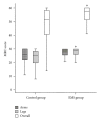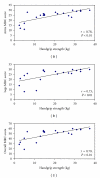Electrical muscle stimulation: an effective form of exercise and early mobilization to preserve muscle strength in critically ill patients
- PMID: 22545212
- PMCID: PMC3321528
- DOI: 10.1155/2012/432752
Electrical muscle stimulation: an effective form of exercise and early mobilization to preserve muscle strength in critically ill patients
Abstract
Purpose. This is a secondary analysis of previously published data to investigate the effects of electrical muscle stimulation (EMS) on strength of various muscle groups in critically ill patients. Methods. One hundred forty-two consecutive patients, with APACHE II score ≥ 13, were randomly assigned to the EMS or the control group. EMS sessions were applied daily on vastus lateralis, vastus medialis, and peroneus longus of both lower extremities. Various muscle groups were evaluated with the Medical Research Council (MRC) scale for muscle strength. Handgrip strength assessment was also employed. Results. Twenty four patients in the EMS group and 28 patients in the control group were finally evaluated. EMS patients achieved higher MRC scores than controls (P ≤ 0.05) in wrist flexion, hip flexion, knee extension, and ankle dorsiflexion. Collectively, the EMS group performed higher (P < 0.01) in the legs and overall. Handgrip strength correlated (P ≤ 0.01) with the upper and lower extremities' muscle strength and the overall MRC scores. Conclusions. EMS has beneficial effects on the strength of critically ill patients mainly affecting muscle groups stimulated, while it may also affect muscle groups not involved presenting itself as a potential effective means of muscle strength preservation and early mobilization in this patient population.
Figures



References
-
- Schweickert WD, Hall J. ICU-acquired weakness. Chest. 2007;131(5):1541–1549. - PubMed
-
- De Jonghe B, Bastuji-Garin S, Sharshar T, Outin H, Brochard L. Does ICU-acquired paresis lengthen weaning from mechanical ventilation? Intensive Care Medicine. 2004;30(6):1117–1121. - PubMed
-
- Bolton CF. Neuromuscular manifestations of critical illness. Muscle and Nerve. 2005;32(2):140–163. - PubMed
-
- Nanas S, Kritikos K, Angelopoulos E, et al. Predisposing factors for critical illness polyneuromyopathy in a multidisciplinary intensive care unit. Acta Neurologica Scandinavica. 2008;118(3):175–181. - PubMed
-
- De Jonghe B, Sharshar T, Lefaucheur JP, et al. Paresis acquired in the intensive care unit: a prospective multicenter study. Journal of the American Medical Association. 2002;288(22):2859–2867. - PubMed
LinkOut - more resources
Full Text Sources
Medical

